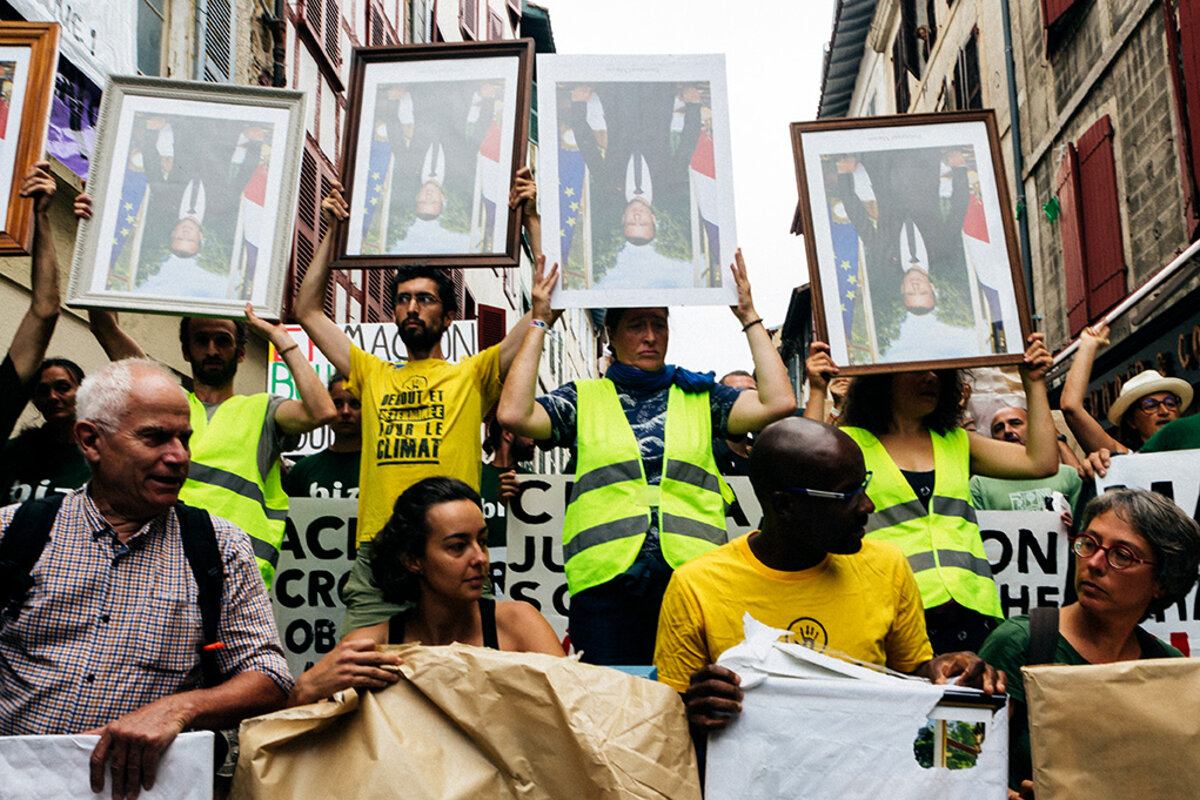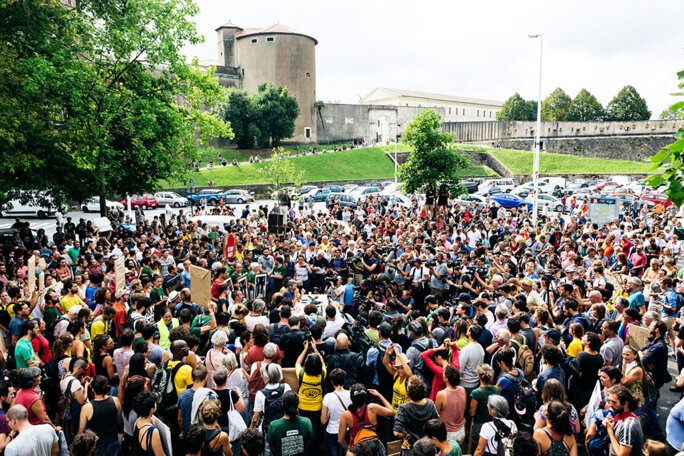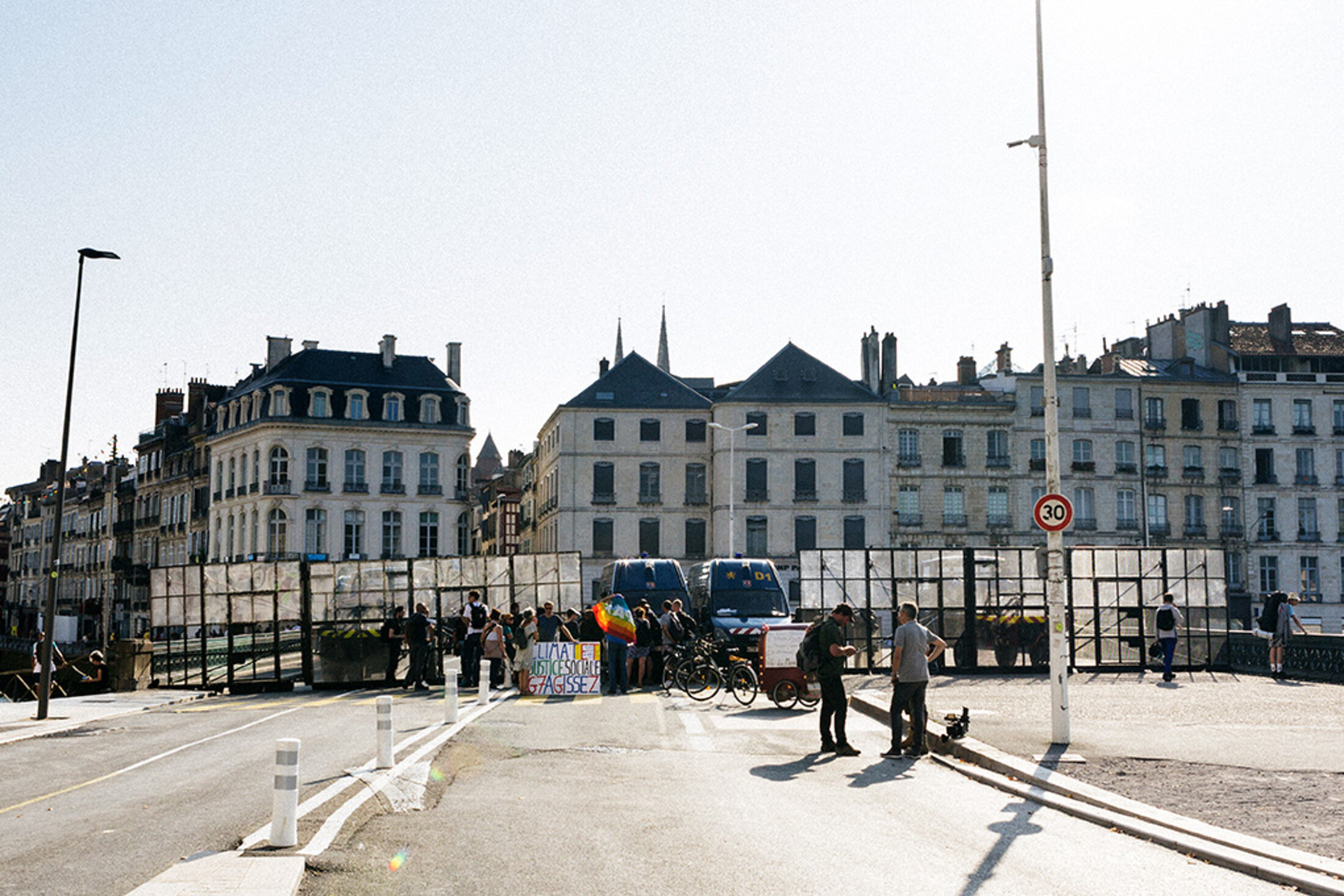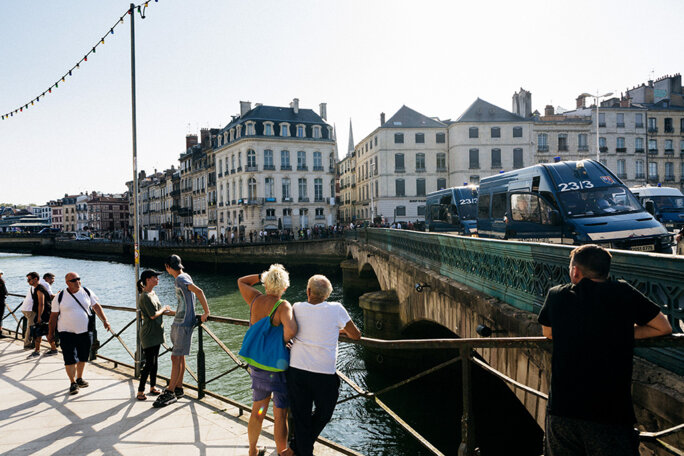Élodie, a member of the climate change action group ANV-COP21, is upbeat as she speaks into the megaphone. “Despite the repression, despite the ban on protesting, we've kept going, and organised this press conference in the most protected zone in the French state!” As she delivers these words in the shadows of the Saint-André church in Bayonne, south-west France, up to a thousand activists from ANV-COP21, Alternatiba and Bizi and other militants, who have come from the G7 'counter summit' around 20 miles away, break into loud applause.
The press conference – which gave voice to opponents of the policies of world leaders at the official G7 summit which ended in nearby Biarritz on Monday August 26th - included social justice activist Susan George, Jean-François Julliard from Greenpeace and Cécile Marchand from ANV-COP 21. An hour earlier journalists had been invited to a spot a few hundred metres away. Here members of the three groups had brandished seven of the 128 official photographs of President Emmanuel Macron that have been taken from mayors' offices across France since February. These 'requisitions' have led to more than 150 activists appearing before French courts.

Enlargement : Illustration 1

Unlike the demonstration at Bayonne on Saturday afternoon, the forces of law and order were visibly fewer in number at this gathering on the morning of Sunday August 25th. The walk around the centre of Bayonne went off without hindrance even if some activists had to identify themselves in order to be allowed through. In addition to the seven real photos of the president, there were also several fake portraits wrapped in brown paper, some with slogans on.
The atmosphere was relaxed. In streets where windows had been boarded up, protest chants rang out: “And 1, and 2 and 3 degrees, it's a crime against humanity”, “We're hotter, hotter, hotter than the climate” and “We're all portrait removers”. During the press conference the participants highlighted what they saw as Emmanuel Macron's double speak on the climate. Once the conference had ended the activists covered up their portraits again and everyone drifted off into Bayonne's streets. The police made no attempt to stop them from leaving.

Enlargement : Illustration 2

There was an altogether different atmosphere at a gathering of 'yellow vest' protesters that took place at virtually the same time in front of the Intermarché supermarket at Bidart, next to Biarritz. There were at most 50 of them in all and they were confined or 'kettled' by riot police for several hours on the spot, with journalists kept at a distance. Meanwhile Amnesty International criticised the searches and obstruction of its observers for two hours at a car park in the town.
At Hendaye, on the nearby border with Spain, demonstrators sought to get into the town's detention centre the Centre de Rétention Administrative (CRA) which had been turned into a temporary prison for the summit, to hold any protestors being detained in custody. But thanks to the heavy police presence the 250 or so protestors had little chance of getting to the centre.

Enlargement : Illustration 3

A few hours later, Bayonne was again in a state of siege. As an anti-fascist group called for people to gather in front of the town hall to demand the freeing of 40 or so activists arrested and held in custody, the many journalists at the scene found themselves confronted with a range of mobile gendarme units and an anti-riot barrier. The atmosphere was bleak, a mood shared among the journalists who struggled to persuade the gendarmes to let them cross the bridge. The outcome was that a demonstration to protest about people who had been arrested did not take place – while four more people were arrested.
In all, and including the counter-summit from August 19th to 25th, around 70 people had been arrested by the evening of Sunday August 25th and about 50 placed in custody. “The forces of order have never entered the [counter-summit] camp but we have put in place a series of controls around the camp and elsewhere in the Basque country,” said a statement from the state prefecture for the county or département of Pyrénées-Atlantiques.
The anti-globalisation activists have been particularly critical of the orders banning people from France, known as Interdictions Administratives de Territoire (IAT). These are ordered by the Ministry of the Interior, and if the person concerned has already entered France they are only notified of them when they have their identity checked or are arrested. In theory they only apply to people who do not reside in France. “One of the organisers of the G7 EZ! [“No to the G7!”] platform, Joseba Alvarez, was stopped near Urrugne [a French Basque village near Hendaye] even though he'd been preparing the Counter-G7 for weeks. He was then informed that he was subject to an IAT issued in July, along with 500 other people. That's what he was told at the police station. Those [subject to an IAT] include many Basque separatist activists,” says Egoitz Urrutikoetxea, of the Iratzar political foundation on the independent Left, and a member of the group organising the counter-summit. “Joseba Alvarez was arrested at 3am [on Sunday] morning, taken to the [detention centre] at Hendaye and taken back at midday to southern Basque country [editor's note, in Spain].”

Enlargement : Illustration 4

German Luke S., who is working in Burgundy in central eastern France, had a similar experience at nearby Saint-Jean-de-Luz on Wednesday August 21st. He had already been sent back from Dijon in eastern France to Germany under an IAT on August 9th in anticipation of the G7 in Biarritz for, among others things “suspicion of having committed acts of violence at the G20 in Hamburg in 2017”. However Luke S., who also works as a journalist for an activist radio station in Germany, had the IAT revoked. “I set off again to Saint-Jean-de-Luz but I had gone to the police station in Strasbourg [editor's note, in north-east France on the border with Germany] and explained to them that I intended to go to the G7 and asked them if I was subject to an order,” he says. “They told me they were not aware of one.”
Having been stopped at a deserted rail platform at Saint-Jean-de-Luz, Luke S. was immediately taken to the detention centre at Hendaye. He stayed there for 18 hours before being put on a plane – a jet plane with 18 seats on which he was the only passenger – to Stuttgart in Germany. “They use these anti-terrorist IAT orders to limit freedom of speech,” says the German.
In the makeshift cells at the detention centre Luke S. came across three young Germans from Nuremberg. Aged between 18 and 22, they were sentenced on Friday August 23rd to between two and three months in prison, and banned from French territory. They were convicted after being stopped in their car and found to be in possession of balaclavas, a tear-gas bomb, an emergency hammer, an adjustable spanner and documents “relating to the far Left”, according to the state prosecutor.
It was these arrests which persuaded the organisers of the protests to “review” their plans for the Rainbow demonstration which was initially planned for Sunday at seven different locations around the red and blue ultra-security zones in Biarritz. These static protests were aimed at criticising the ban on demonstrating. The state prefecture had not been officially notified of them.
“It was important to highlight the siege State. But the authorities stopped any opposition with preventative arrests,” says Sébastien Bailleul, one of the spokespeople for the Alternative G7 group. “Three representatives of the [human rights league] Ligue des Droits de l’Homme were arrested, some journalists were stopped and their [protective] equipment taken [editor's note, in Bayonne]. All that made us think and we were not in a position to guarantee the activists' safety.”
The cancellation of Sunday's gathering, which were not widely broadcast on social media, was greeted with anger by demonstrators, some of whom accused the organisers of playing into the government's hands. “We understand their disappointment, we were as disappointed as anyone ourselves, but we couldn't take the risk of putting the demonstrators at risk while the forces of law and order were being aggressive,” explains Sébastien Bailleul.
A colleague from the Basque group G7-EZ! agreed. “We had a consensus over action in the Basque Country to respond democratically to the forces of law and order,” he says. “We made a strategic choice, after the Arnaga declaration [editor's note, made by Basque separatist group ETA in May 2018]. We're not disappointed, all these arrests highlight the fact that the state is not acting democratically.”
The various groups prefer to vaunt the “success” of the counter-summit. “We counted around 5,800 people attending the conferences and the workshops that were set up. We counted up to 4,000 people at the campsite,” says Sébastien Bailleul. On Sunday morning there were still 1,200 present at the site, a half of whom went during the day. As for the official G7, that passed off without disturbance. Even the visit of the G7 'First Ladies' to the French Basque village of Espelette – known for its red peppers – was only disturbed by the unfurling of one banner between two windows.
-----------------------------------------------------------------------
- The French version of this article can be found here.
English version by Michael Streeter


